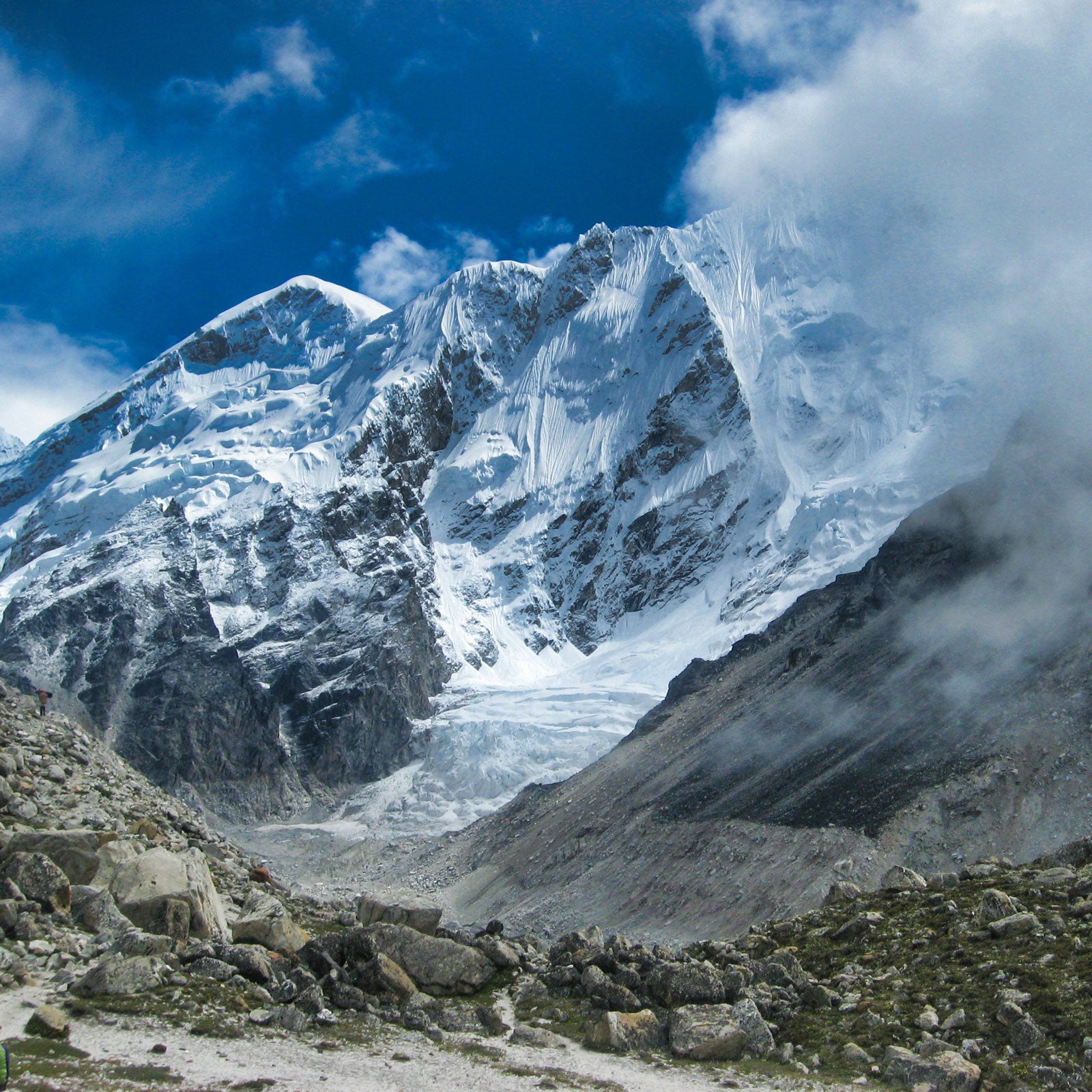The number of people heading into the backcountry in recent years. And with it, a whole industry of gearmakers and educators have��cropped up to try and help people navigate the terrain safely. Brands regularly release what they claim are increasingly efficient and effective tools, and avalanche centers offer greater opportunities��for education.
The backcountry poses risks beyond avalanches: exposure, gear failure, injury, even hazards like rockfall and tree wells.��With so many factors at play—weather, navigation, snow stability, and access to emergency rescue, to name a few—wintertime��mountain travel can feel daunting for a beginner.��
Slides can happen anywhere,��and slide paths can extend far into valley floors and flat terrain—so��when you’re determining whether you’re at risk, don’t forget to evaluate the terrain above you, too. But the truth is, it’s impossible to be 100 percent safe, no matter how well prepared you are, and you do need a set of foundational skills to enter this terrain in the first place. So we called up Simon Trautman, the national avalanche specialist for the U.S. Forest Service and the director of forecasting at the Northwest Avalanche Center, to help sort out what backcountry beginners need to know.
Getting Started
Before you pick up your first backcountry setup, Trautman encourages all skiers and snowboarders to take a sober evaluation of what he calls their mountain sense.
“I’ve seen a lot of people taking avalanche classes and accessing the backcountry that have very little mountain experience,” he says. “If something goes wrong—you get hurt, delayed, you can’t stay warm—it doesn’t matter how much you know about snow.” He emphasizes that everyone must know how to pack appropriately (read: food, water, layers) and be properly equipped to deal with emergencies. You should be an expert skier comfortable in all conditions and on all in-bounds slopes, and have an understanding of basics like navigation, how to read terrain, and what to expect from mountain weather.��
The three critical pieces of backcountry gear are a ��($335), ($50), and ��($80).��Beacons come in two broad categories: two and three antennae. If you’re shopping for a new one, opt for a three-antennae version, which typically offers a longer range and more precise search, especially in dual-burial scenarios. Be sure to buy a metal shovel—plastic isn’t strong enough to cut through cement-like avalanche debris. Probes come in a variety of lengths, but a shallow snowpack can still produce deep debris fields, so beyond weight-saving and budget, there's no reason to opt for a shorter one given the choice.
“Depending on where you’re recreating, you have different needs and different constraints, and sometimes you need tools that you don’t need in another situation,” says Trautman. Equipment��like ��($500), ��($180), and emergency communication devices like ��($350) or ��($450) are excellent tools to add to your kit. But in avalanche terrain, the bare minimum includes a beacon, shovel, and probe.��
Equipment doesn’t do you any good if you don’t know how—or where—to use it. Once you’ve acquired the right tools (and a ��to carry it), start plugging into educational resources that will offer training and practice with your��equipment.
Education
Trautman points beginners in the U.S. to . It’s an invaluable resource that collates data from all the avalanche centers in the lower 48 to offer information about forecasts, educational opportunities, and incident reports. Their to snow safety is an excellent place to familiarize yourself, including unfamiliar terminology and gear. He also recommends websites like , , and for those looking to learn more on the web.
You can also use ��to check out conditions and connect with your —which, if you’re lucky enough to have one, will become one of your most valuable assets as a backcountry skier. An avalanche forecast offers information about how likely avalanches are, what type and size of avalanches are most probable given the conditions, and what elevations and aspects pose the greatest risk. It also includes a discussion of the factors—snowpack, storms, and weather—that contributed to those problems.��“Just reading the advisories and paying attention to the avalanche danger as it fluctuates throughout the winter will teach you a lot,” says Trautman.
Next, think about attending an avalanche��awareness class.��What��Trautman considers��the traditional path of avalanche education starts here, with classes typically put on by��local avalanche centers, backcountry outfitters, and guide operations. These courses don’t have an official curriculum and offer an entry-level introduction to the problems inherent to��backcountry travel��including terrain choice, snowpack stability, and interpersonal dynamics and group decision-making. They’re usually free, though more involved courses—like the popular daylong��—can cost up to $140��and will go into greater depth on relevant subjects. Awareness classes are typically unaffiliated with��the (AIARE), the standard-bearer for avalanche training in the United States. More advanced classes are facilitated by AIARE.��
After you’ve read up on your local forecasts, attended an avalanche awareness class, and checked out the available resources, sign up for an official AIARE Level 1 course (or, if you're farther north, a Skills Training 1 course with ). This in-depth course spans three days—including classroom and field time—and offers students “an introduction to using decision-making tools to help a group manage risk while traveling in avalanche terrain,”��per the AIARE course descriptions. Along with exercises in communication and group dynamics in high-risk situations, you’ll learn the basics of evaluating snowpack, terrain, and weather, and practice rescue techniques. A level one typically costs between $400 and $500, but certain providers—like ��in the Lake Tahoe area—offer courses for as low as $275.
AIARE also offers , intended to be an in-depth class on emergency rescue for beginners, as well as a useful refresher for experienced backcountry skiers and snowboarders. They encourage students at every experience level to retake this course regularly.
All that said, education can only go so far, according to Trautman. “Just taking an educational course is not going to teach you everything you need to know about mountains or snow,”��he��says. “These courses are very important, they’re fundamental, but they’re all just giving you the language to communicate. The best thing to do after your course��is to get outside, get your own experience, find those people you feel you can recreate safely with.”��Once you build up your own knowledge base, says Trautman, you can go back and take an AIARE Level 2, a three-day course focused more heavily on forecasting and snow science. ��
Support and Experience
When Trautman started skiing in the backcountry, the resources available to skiers were far more limited than they are today. “It was more like a mentorship in some ways,” he says. “You would look for someone who knew what they were doing and glom onto them until you felt like you knew what you were doing.”
When choosing a backcountry partner, Trautman emphasizes good communication above anything else, even years of experience. “If you can’t communicate with your partners, then it’s really hard to make good decisions and to learn,” he says. Beyond that, he recommends finding someone with similar risk tolerance��and��outlook on life. “People that are trustworthy in most situations are also trustworthy in the backcountry. Beyond that, they have to have the experience to make good decisions and have good intuition,”��he says.��
Looking for a partner? Trautman recommends taking your Level 1 close to home. “You’ll probably meet somebody you’ll be friends with for life,”��he says. Awareness classes will be filled with beginners looking to connect with like-minded people, too.
If you aren’t lucky enough to have a good partner where you live, or if you’re traveling in unfamiliar areas, consider hiring a professional mountain guide. Not only will you get the opportunity to ski higher-consequence terrain than you might be able to safely move through on your own, but they’re also an excellent resource to learn from, no matter how experienced you are.


